MXA RACE TEST: THE REAL TEST OF THE 2021 HUSQVARNA FC450
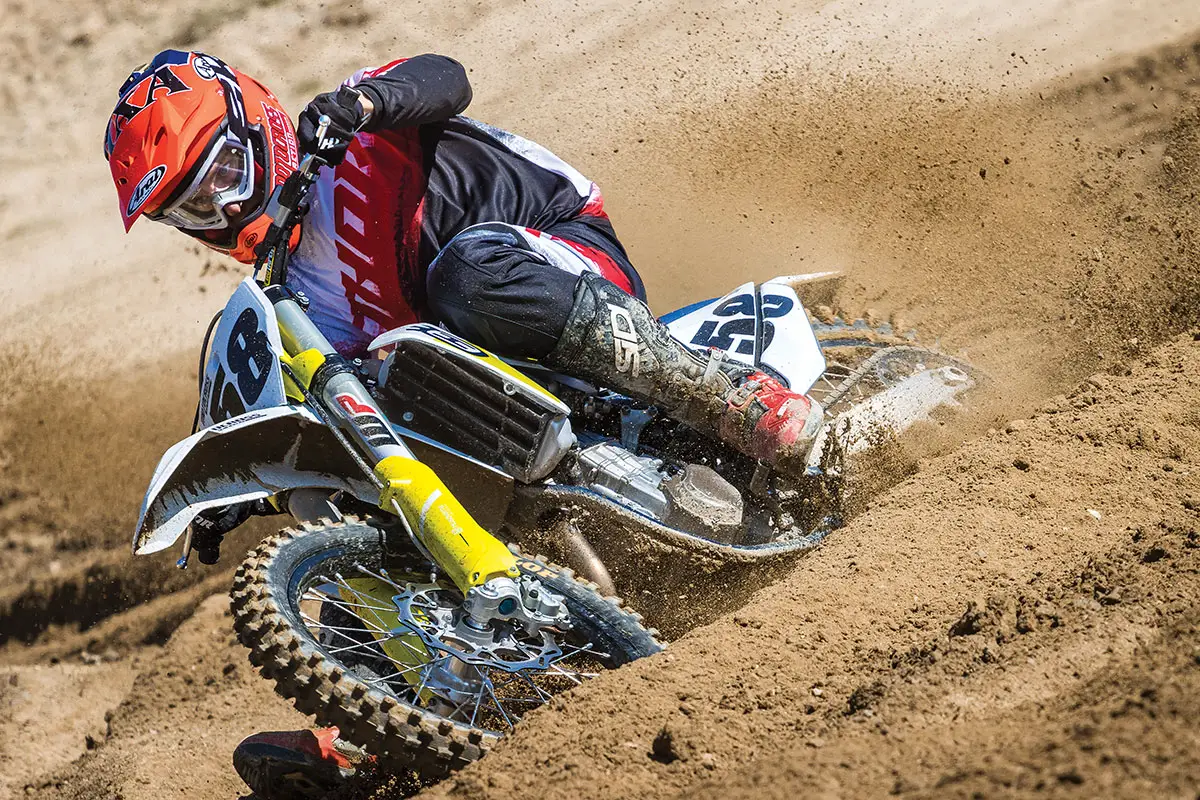 THE GEAR: Jersey: Thor MX Sector, Pants: Thor MX Sector, Helmet: Arai VX-Pro4, Goggles: EKS Brand Flat-out, Boots: Sidi Atojo.
THE GEAR: Jersey: Thor MX Sector, Pants: Thor MX Sector, Helmet: Arai VX-Pro4, Goggles: EKS Brand Flat-out, Boots: Sidi Atojo.
Q: FIRST AND FOREMOST, IS THE 2021 HUSQVARNA FC450 BETTER THAN THE 2020 FC450?
A: Yes. Significantly better in terms of suspension, handling, mapping and chassis setup.
Q: WHAT’S DIFFERENT ON THE 2021 FC450 VERSUS THE 2020 FC450?
A: When you compare the 2021 production FC450 against the 2020 production FC, it is obvious that Husqvarna’s engineers made focused changes to the 2021 model. The improvements aren’t just noted in the brochure; they are felt in the saddle. These changes are to the forks, shock, rising-rate linkage, seat cover, fork air pressure, tires, shock spring rate, fork rebound clickers and ride height.
Q: WHAT’S NEW ABOUT THE 2021 HUSQVARNA WP XACT FORKS?
A: At first glance, the 2021 WP air forks look identical to the 2020 WP forks. Nothing could be further from the truth. Every internal piece of the 2021 fork is different, and that includes the valving, oil passages, air chambers, cartridge rods and bottoming system, and each and every one of these mods is a creative new take on air forks.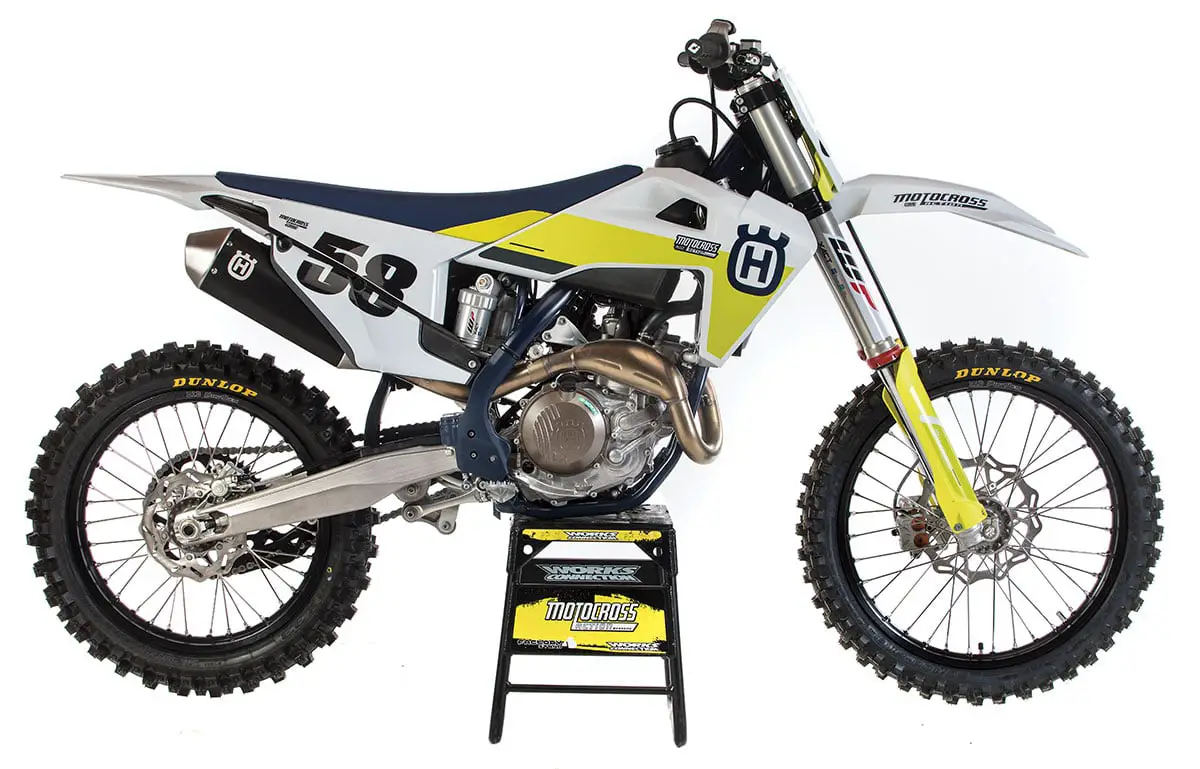 The best thing about the 2021 Husky FC450 is its powerband. No, it is the suspension. No, it is the handling. Whatever it is, we like it.
The best thing about the 2021 Husky FC450 is its powerband. No, it is the suspension. No, it is the handling. Whatever it is, we like it.
Last year, Husqvarna made big waves by dropping its KTM-clone front forks and blazing its own path. In 2020, Husqvarna succeeded in lessening mid-stroke harshness, improving front tire contact and increasing overall comfort. It felt like a completely different fork‚ even though it was just a reshuffle of the previous fork’s component order and execution. The only audience that had issues with Husky’s 2020 fork setup were the Pros. It wasn’t stiff enough for them. Husqvarna countered that virtually every Pro rider sends his forks out to have them re-valved for their speed, as do heavy and skinny guys, so why punish the largest group of FC450 buyers by catering to riders at the extremes of the curve? It was a success story.
Q: IF IT WAS A SUCCESS STORY, WHY DID HUSKY DESIGN ALL-NEW FORKS?
A: Remember when we said Husqvarna’s 2020 fork changes were “just a reshuffle of the previous fork’s component order and execution.” A light bulb went off in Husqvarna’s R&D department when the 2020 fork mods were so well-received, even though they were built from existing 2019 internals in different portions. It got them thinking, “If we could make such a big improvement with the old parts, what if we redesigned every part?”
And that is what they did on the 2021 WP Xact air forks. Here is a breakdown.
(1) Fork length. The 2021 WP Xact forks are 10mm shorter than the 2020 forks. Husqvarna shortened the cartridge rods by 10mm and made a corresponding 10mm reduction in the length of the WP stanchion tubes. Why go to all that trouble when a spacer inserted into the forks could have achieved the same 10mm-shorter forks? Husqvarna shortened both the cartridge rods and stanchion tubes to maintain the same separation between the bushings in the stanchions and fork internals. This increased fork rigidity while eliminating a spike in damping pressure. Now you might ask, “Why did Husky shorten the forks in the first place?” We’ll get to that later.
(2) Oil-bypass notches. Oil bypass notches reduce oil-pressure peaks when the stanchion bushing and cartridge bushing get close enough together to compress the fork oil. The oil-bypass notches in the forks allow the oil pressure to escape.
(3) Negative chamber. When an air fork’s air pressure is compressed, it builds up pressure at the top of the fork’s inner cavity. If something isn’t done about the pressure buildup, the fork will spring back on rebound way too fast. This is called topping out. The solution to topping out was to add a negative air chamber that held enough air pressure to control the rebound stroke. WP’s engineers invented a way to use the fork’s compression stroke air pressure on the rebound stroke to stop topping out. This was achieved by putting a cross-over bleed slot in the middle of the compression stroke to allow the pumped-up air pressure to leak into the rebound side of the fork to resist downward acceleration of the fork tubes. It was an ingeniously simple idea. For 2021, they doubled the length of the cross-over bleed slot in coordination with enlarging the size of the negative air chamber air space for more progressive air pressure on the negative side.
(4) Air seal. Since the oil bypass notches relieve oil-pressure buildup in the damping leg, WP decided to do the same thing on its air pressure leg. WP put four bypass holes in the air seal to lessen air pressure spikes.
(5) Trampoline valve. Unlike on a traditional mid-valve shim stack, WP added a “trampoline shim,” so called because, unlike a normal shim that is tightly packed in by other shims and the piston, the trampoline shim has room to bend. It is given room to bend by being located above a small cavity that allows more damping in the mid-valve without making the damping stiffer at the end of the stroke.
(6) Bottoming cone. The 2020 bottoming cone in the damping leg has been replaced with a bump-stop rubber O-ring on the 2021 fork.
(7) Rebound adjuster. You do not need to get down on your knees with a screwdriver to adjust the rebound damping; you can now turn the rebound clicker under the right fork leg by hand.
Q: HOW DO THE NEW WP XACT FORKS WORK?
A: There are lots of anti-air fork advocates in the motocross world. Sadly, many of them have not ridden with the latest WP Xact air forks; many never took the time to learn how to set their air forks up to work, and many don’t even own a bike. They are just nattering nabobs of negativism spouting off with no factual basis for their opinions.
The 2021 Husqvarna Xact air forks are a giant step forward for WP. All of the internal modifications are designed to make the stroke more fluid, reduce pressure spikes, bleed off excess oil pressure and reduce the effects of an air fork’s hyper-progressive spring rate at the end of the stroke. And, we think that WP made major steps forward in its fork performance for 2021.
To take advantage of the added performance, the rider has to learn to balance the work load of the fork’s air pressure and its damping clickers. Too many riders make damping changes by changing the air pressure, which makes no sense. Once you find the correct air pressure for your weight, speed and style, all tuning should be done with the clickers. If you never take the time to find your proper air pressure, you will never fix your WP forks with the clickers.
Faster MXA Pro test riders ran the recommended 10.7 bar (155 psi) or higher. Intermediates ran 10.3 bar (150 psi), and Novices and Vets ran 9.6 bar (140 psi). MXA had test riders who ran over 11 bar and riders who ran under 9.6 bar as well.
Q: WHAT ABOUT THE WP SHOCK?
A: In 2020, Husqvarna spec’ed a light 42 N/mm shock spring, upped the compression damping and lightened the rebound. Last year’s shock worked well, but most MXA test riders, fast or slow, added more high-speed compression (from 1.5 turns to 1.25 turns) and more rebound (from 15 clicks out to 10 clicks out). If the test riders were still troubled, we installed a complete Pro Circuit shock linkage and bell crank. It split the difference between the rising-rate curve of the wallowy 2015 linkage and the overly harsh 2016–2020 linkage. The only downside was that it demanded a stiffer shock spring (48 N/mm or higher).
Given these facts, MXA wasn’t surprised that for 2021 Husqvarna changed its complete OEM shock linkage (linkage arms and bell crank). But, we were surprised about the corresponding changes. First, the 2021 Husqvarna shock link arms are longer ( 0.5mm longer). This change drops the seat height a little and makes the starting point of the shock’s rising rate higher on the curve.
Paradoxically, Husqvarna didn’t want the rising rate to start at a stiffer point on the curve, so they designed a new bell crank that brought the starting point down in spite of the longer link arm; however, because they changed the linkage arm length, they needed to up the spring rate from 42 N/mm to 45 N/mm. And, in the biggest change of all, Husqvarna raised the seal head cap on the shock by 6mm. That doesn’t make much sense on its face, but what this means is that the shock shaft’s travel was limited by 6mm (from 140mm to 134mm). This stops the rear tire from hitting the fender. The result of the link arm, bell crank and seal head changes was 10mm-less shock travel. When extrapolated out to the chassis, this makes the seat height lower.
Q: WHY DID THEY SHORTEN THE FORKS IN THE FIRST PLACE?
A: Husky shortened the forks because they planned to shorten the shock, and the overall result is a very noticeable improvement in handling. The 2021 Husqvarna FC450 rails through corners, feels much smaller between your legs and allows body English to have more effect. The FC450 flat out handles better—and that is the first thing that every MXA test rider gushed about after his first test ride. It was a great-handling bike before, but now it is better.
We accept your skepticism that making the 2021 Husqvarna 10mm lower could make so much difference, but that is because we didn’t tell you that a 10mm-shorter shock results in a 25mm lower seat height. When you add in the 10mm-shorter forks, which can be slid up and down in the triple clamps, you get a bike that is over an inch lower than it was in 2020.
Lots of riders can’t touch the ground when they are sitting on a motocross bike. They complain, MXA complains, but they are ignored. Husqvarna listened. If you are shorter, you will love the 2021 Husqvarna FC450. Motocross bikes are too tall, but finally one motorcycle manufacturer has done something about it.
Q: HOW DOES THE 2021 HUSQVARNA FC450 RUN ON THE DYNO?
A: This is an awesome engine. It is so easy to ride that you can’t believe it is fast; it pulls so far that you think it will never stop; it hooks up like it’s glued to the track, and it’s much smoother than the typical rock ’em, sock ’em 450 powerband. When you first start riding it, you think that it revs slow and that it is mellow through the middle and not all that sparkling on top. But, then you notice that you are flying. It doesn’t beat you up, jerk your arms out of their sockets or scare you at max velocity. The sensation of speed, or lack thereof, plays tricks on your mind because the 2021 FC450 engine produces more horsepower from 6000 rpm to 9000 rpm than the KX450, RM-Z450 or YZ450F — a lot more. The FC450 is 2 to 3 horses up on the green and blue bikes to nine grand (and stays above the KX450 all the way to sign off). The Yamaha YZ450F does catch up to the FC450 at 10,000 rpm but never makes a full horsepower more. Even worse for the KX450 and YZ450F is that the FC450 pumps out 36.37 pound-feet of torque, while the KX450 is at 34.83 and the YZ450F sucks wind at 34.36.
We are unbelievably impressed that a bike making this much power and torque can feel like it is just gliding along. Great engine.
Q: HOW DOES THE 2021 HUSQVARNA FC450 RUN ON THE RACETRACK?
A: Every MXA test rider—Pro, Intermediate, Novice and Vet—fell in love with the 2021 Husqvarna powerband. It was incredibly easy to ride. The combination of the plush suspension, perfect geometry and a lower overall center of gravity allowed the FC450 to carve around corners. Even the Pro test riders loved it. It only took them one race to realize that the kinder and gentler Husqvarna powerband enabled them to ride harder, get on the gas sooner and be more aggressive in the tight stuff. The FC450 power is so well modulated that there are no burps, surges or abrupt hits anywhere on the curve. It is easy to go fast when the bike you are riding doesn’t fight you.
Q: WHAT DID HUSQVARNA DO TO THE 2021 FC450 MAPPING?
A: Back in 2019, the MXA wrecking crew went to a map test with the Austrian engineers. Of the half dozen test riders there that day, all of them chose the exact same map. It came to be called the “American map.” The American map was incredibly crisp, very responsive and strong from low-to-mid. We aren’t telling tales out of school to say that we expected the Austrians to make the “American map” the new Map 2 on the 2020 Husky FC450. We didn’t get it. And we didn’t get it in 2021, either, but there is no doubt that the Map 2 that they downloaded in the 2021 FC450 is much better than last year’s Map 2. There is a bigger difference between map one and map two, which we like. When the racetrack was loamy and soft, we ran Map 2, and when the track was dry, hard and sketchy, we ran Map 1. In most cases, we ran Map 1 in combination with traction control.
Q: WHAT DID WE HATE?
A: The hate list:
(1) Bolts. Check the spoke nipples and rear sprocket bolts at very regular intervals.
(2) Seat bolt. You have to remove the air box cover to get to Husqvarna’s very unique single seat bolt and we don’t like the tug of war that it takes to get the Husky side panel off (see below for advice on how to do it).
(3) Airbox cover.It is so long and flexy that it is hard to remove. We stick an 8mm T-handle in the back end and pop the prong out of the rubber grommet.
Q: WHAT DID WE LIKE?
(4) Compression clicker. We don’t need more or less prongs, we need longer prongs.
(5) Vented airbox. We wish that Husky’s vented airbox had holes as large as KTM’s vented air box.
Q: WHAT DID WE LIKE?
A: The like list:
(1) Brembo brakes. The Big Four Japanese brands have been throwing 270mm rotors on their old-fashioned master cylinders and calipers to try to keep the 260mm Brembo brakes in sight.
(2) Magura hydraulic clutch. The major difference between the Magura and Brembo clutch feel is that the Magura clutch pull feels smoother and more linear, while the Brembo has that “pop” feel that tells the rider when the clutch is disengaged.
(3) Weight. At 224 pounds, the 2020 Husqvarna is 14 pounds lighter than the YZ450F. If you don’t think that 14 pounds makes a difference on a race bike, you need to take up tiddlywinks.
(4) Throttle cam. Your Husky sat on the showroom floor with the stock, long-throw throttle cam installed. Take it out and put on the quick-turn black throttle cam that your dealer gave you on the way out the door.
(5) Twin Air filter. If you’ve never installed an air filter into a KTM or Husqvarna, you will be amazed at how foolproof it is compared to the normal gymnastics of other air filter/cage/airbox designs.
(6) Linkage seals. The shock linkage operates on new, low-friction SKF seals for freer movement of the new shock linkage.
(7) Radiator cap: Husky and KT are the only production models that come with 1.8 high pressure rradiators keeps to cut down on overheating.
(8) Tires. For 2021, Dunlop MX33 motocross tires replaced last year’s MX3S tires. We have warm feelings towards the MX3S front tire, even if it does chunk knobs.
(9) Wheels. The black-anodized D.I.D. rims are mated to CNC-machined hubs using lightweight spokes and silver anodized aluminum nipples.
(10) Handlebars. We love the resilient feel of the ProTaper handlebars and the ODI lock-on grips.
(11) Seat. Last year’s Husqvarna seat cover had a grudge against the seat of your pants. The new seat cover is less abrasive.
Q: WHAT DO WE REALLY THINK?
A: If you are looking for a bike that will make you a better rider, allow you to make cuts that were out of the question the week before, has incredible brakes, a clutch that you can’t burn up and hauls mail down the roughest straight as though it were smooth, then this is the bike for you. We can’t claim that everyone will like it, but we can tell you that at the weekly SoCal races, the MXA test riders fight over who gets to race the 2021 Husqvarna FC450.
The three best things about the 2021 Husky are: (1) Our feet can touch the ground on the starting line. (2) It goes very fast without the drama. (3) It turns so well that the words “oversteer” or “understeer” will never be used again. From the outside, the 2021 Husqvarna FC450 looks very much like the 2020 model. It isn’t.
From the outside, the 2021 Husqvarna FC450 looks very much like the 2020 model. It isn’t.
MXA’S 2021 HUSQVARNA FC450 SETUP SPECS
This is how we set up our 2021 Husqvarna FC450 for racing. We offer it as a guide to help you find your own sweet spot.
AER FORK SETTINGS
Every year you read press releases about new bikes that say, “All-new fork valving.” But, the 2021 FC450 has all-new forks, from top to bottom, inside and out, and they throw in all-new valving as a bonus.For hardcore racing, we recommend this fork setup for an average rider on the 2021 Husqvarna FC450 (stock specs are in parentheses):
Spring rate: Pros: 10.7 bar, 155 psi; Intermediates: 10.3 bar, 150 psi; Novices/Vets: 9.6 bar, 140 psi.
Compression: 15 clicks out (12 clicks out)
Rebound: 10 clicks out (12 clicks out)
Fork-leg height: Third line
Notes: Bleed the outer chambers of the WP forks at regular intervals. Reset the air pressure to your chosen settings between motos (once the forks have cooled down from riding). There are MXAtest riders who run 160 psi and test riders who run 133 pis, so experement to find you perfect air pressure.
WP SHOCK SETTINGS
Most MXA test riders added more high-speed compression and more rebound. MXA test riders don’t stray far from the stock 15 clicks out on low-speed compression, relying on the high-speed and rebound adjustments to have a crossover effect on the whole shock. For hardcore racing, we recommend this shock setup for the 2021 Husqvarna FC450 (stock specs are in parentheses):
Spring rate: 45 N/mm
Race sag: 105mm
Hi-compression: 1-1/4 turns out (1-1/2 turns out)
Lo-compression: 15 clicks out
Rebound: 10 clicks out (15 clicks out)
Notes: We turned the high-speed compression damping in a 1/4 turn to lessen G-outs and run more rebound than the recommended setting.




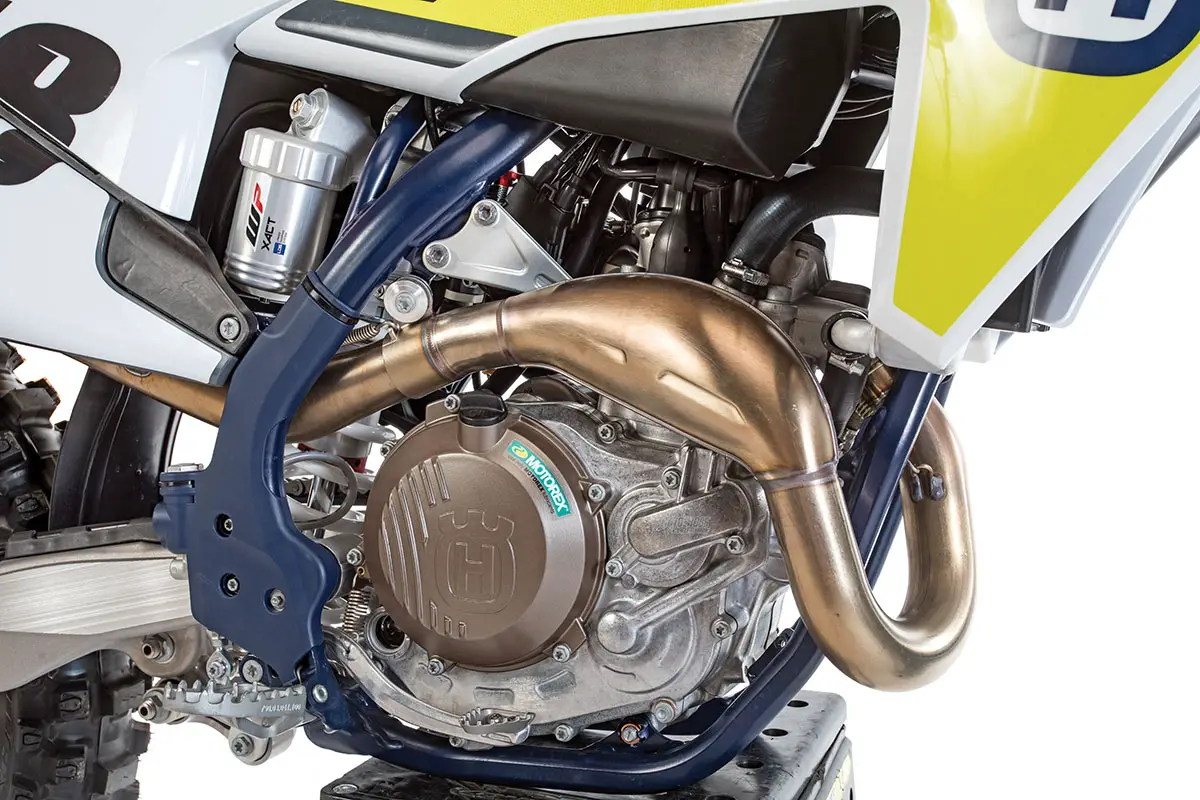



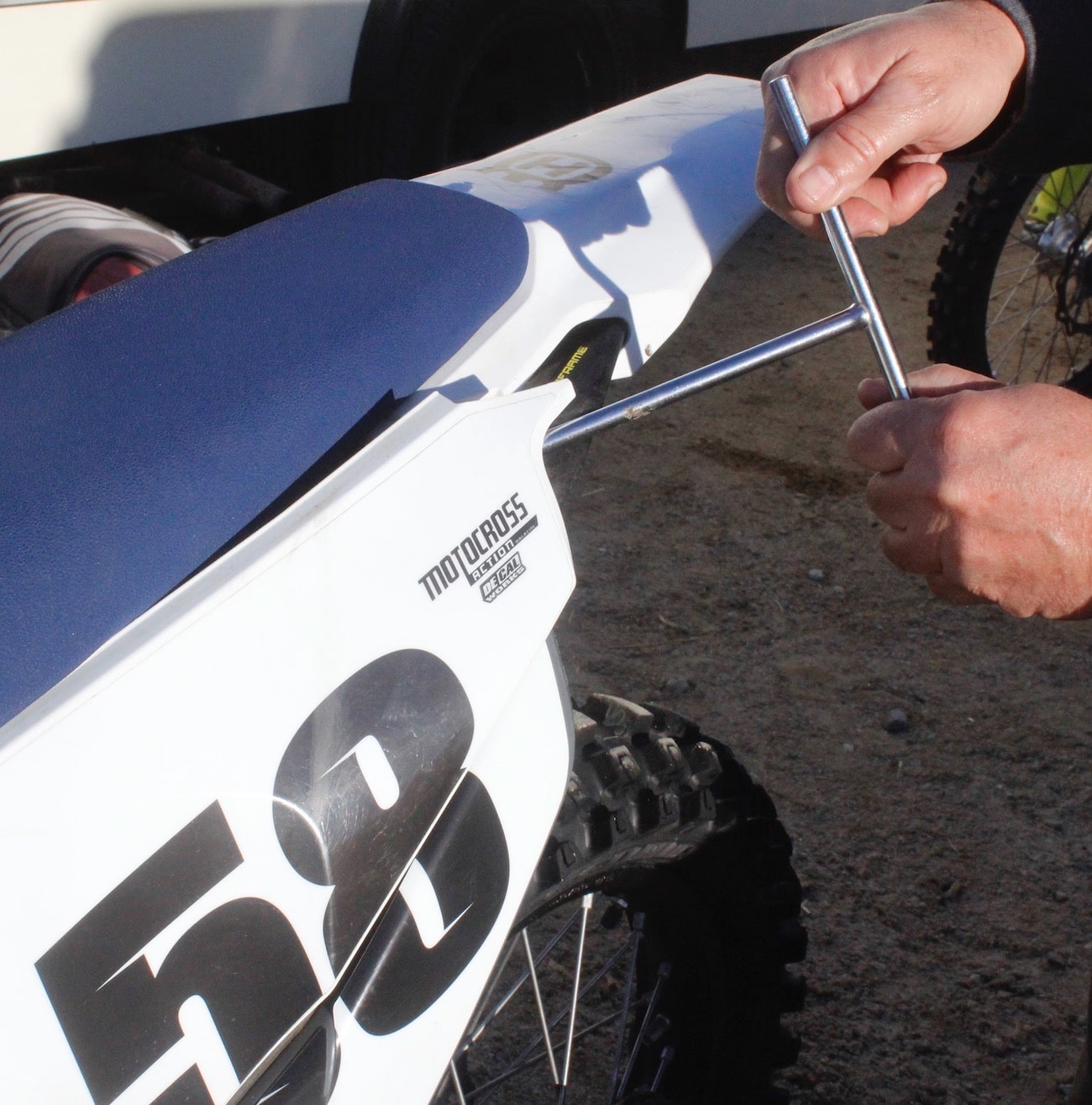
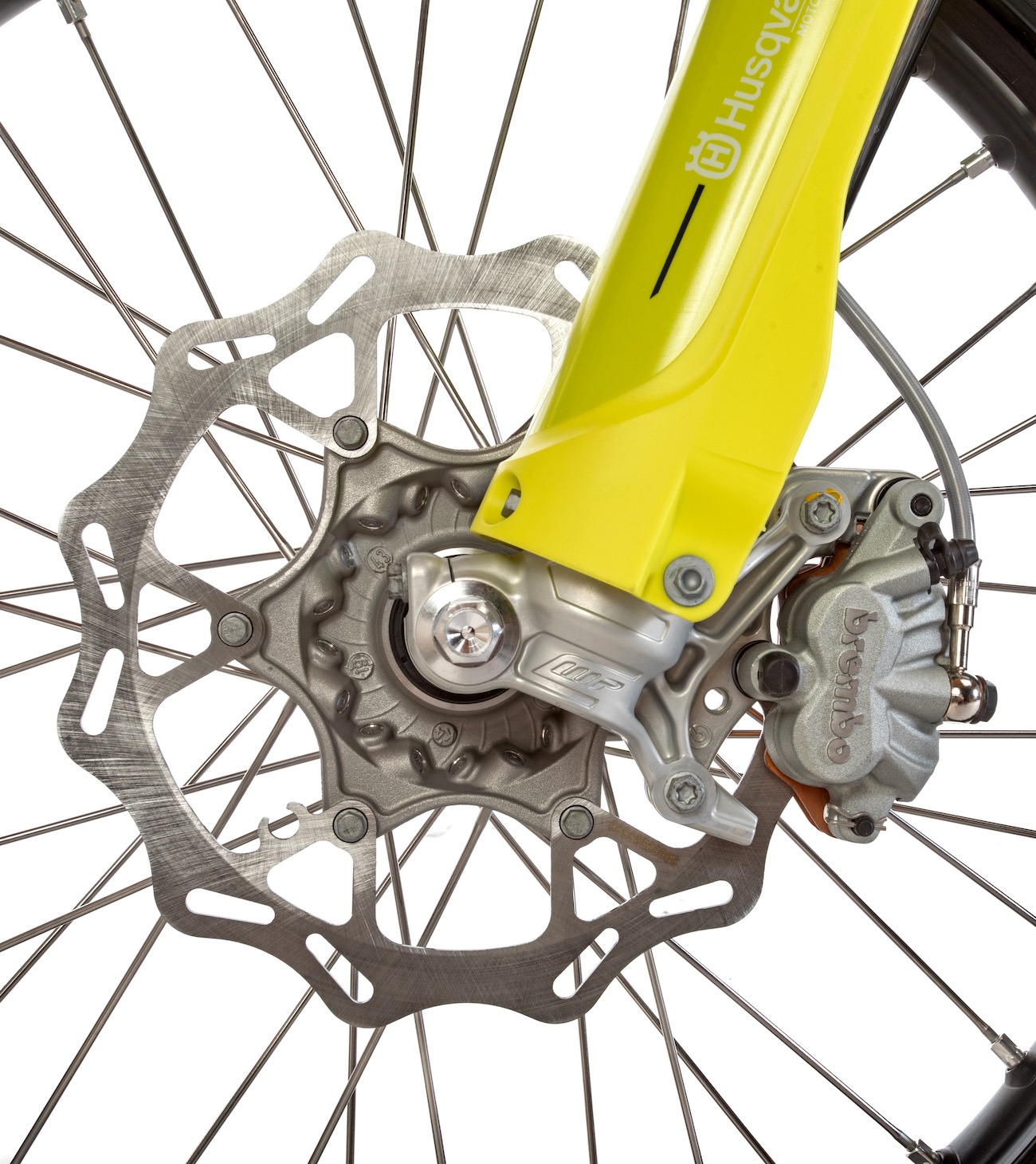
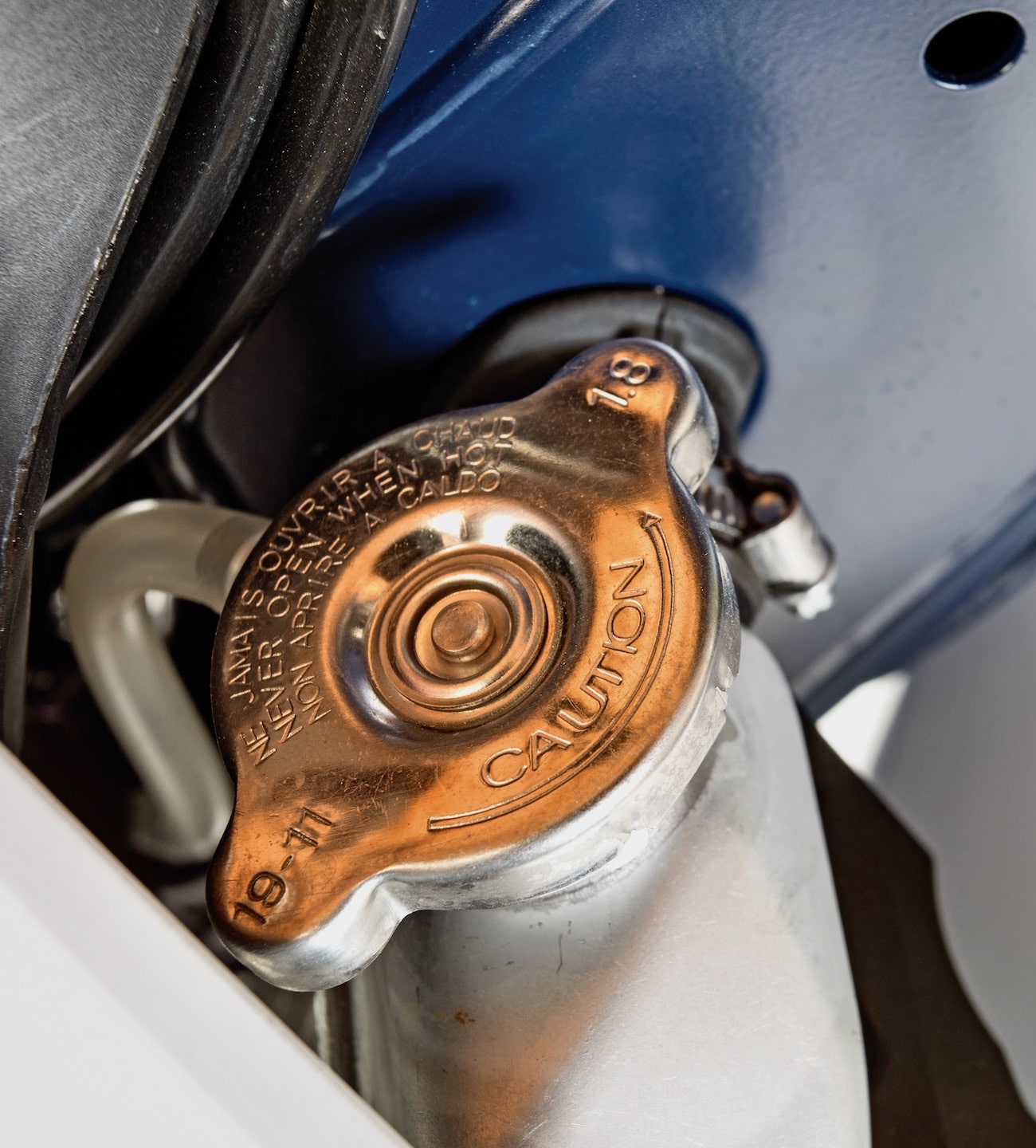

Comments are closed.